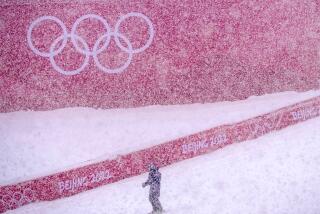Time to slow down?
- Share via
Reporting from Whistler, Canada — Just how fast is too fast?
Throughout the lead-up to the Winter Games, reporters asked athletes and athletes asked themselves about the risks of sliding on a track labeled the world’s fastest.
The mile-long concrete chute lined with a veneer of ice is the venue for luge, skeleton and bobsled. It is the longest course in the world, with a vertical drop from start to finish of 45 stories. There are 16 curves with nicknames such as Shiver and Wedge and 50/50--the latter coined by USA 1 bobsled driver Steve Holcomb because there’s only a 50% chance of getting through it without crashing.
At a news conference Thursday evening, Mark Grimmette, a five-time Olympian and the U.S. flag bearer in the opening ceremony, hardly hesitated when asked about track safety.
“I think we’re probably getting close, too close to the edge,” said the silver and bronze medalist. “It’s something they definitely have to take into account when they design future tracks.”
Cruelly, the Thunderbird curve where Georgian luger Nodar Kumaritashvili died Friday is not one that raised a great deal of concern among the athletes. And it appears he struck the back of his neck below his protective helmet on a steel roof support beam, just beyond where the padding ends.
Most athletes -- acknowledged speed junkies -- use words like, “fast,” “technical” and “challenging” to describe conditions at the Whistler Sliding Center. Few want to publicly back down from a challenge, especially in an Olympic year.
But the Whistler track has raised the upper limits of luge speeds from 80 mph to 95 mph, with sliders predicting that mark will fall over the next week.
Tony Benshoof, the American luger who holds the Guinness record for fastest run (86.6 mph), noted that at 97 mph, a slider could go airborne in Curve 14, part of a labyrinth known as the Gold Rush Trail.
“World Cup ice has been fast. Olympic ice will be perfect for that kind of speed,” he said.
The track was designed by German engineer Udo Gurgel, who also drew the blueprints for the 1998 Nagano, 2002 Salt Lake and 2006 Turin Olympic Games. This isn’t the first time track design and safety have become an Olympic issue.
After numerous athletes crashed in training on the 2006 track, Turin organizers rebuilt portions of it even as some sliding sports officials dismissed concerns. And still, sliders were injured, most notably Samantha Retrosi of the U.S., who was left unconscious after a horrific crash near the bottom of the course.
Kumaritashvili’s death brings to four the number of athletes who have died at Olympic training fatalities. Three have died at the Olympics.
Two athletes died before the start of the 1964 Innsbruck Games: Australian Alpine skier Ross Milne and British luge slider Kazimierz Kay-Skrzypeski.
In 1966, world champion Italian bobsled driver Sergio Zardini, a two-time Olympic medalist, was decapitated when his sled went out of control and slammed him against the wooden railing at the top of the track at Lake Placid, N.Y.
No Olympic athlete has died during Winter Games competition.
There are two issues that Olympic officials and the international federations will have to address, if not now then before 2014: At what point do track conditions cause athletes and equipment to fail and should less-talented athletes be protected in some way?
Network sliding-sports commentator John Morgan, a former bobsledder, said concerns have been raised about middle- and lower-level performers.
“As I said for a couple years, I’m not worried about the top 12 people,” said Morgan, who was at the scene of crash. “I’m worried about the 12 back.”
But even some top athletes were worried before Kumaritashvili’s death.
Russia’s Albert Demtschenko, six-time Olympian and two-time World Cup champion, sounded this warning at a Thursday news conference: “Eyes open all the time because it’s a dangerous track. Open eyes.”
candy.thomson
@baltsun.com
Freelance reporter Meri-Jo Borzilleri contributed to this report.
More to Read
Go beyond the scoreboard
Get the latest on L.A.'s teams in the daily Sports Report newsletter.
You may occasionally receive promotional content from the Los Angeles Times.






